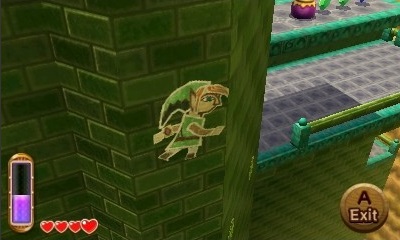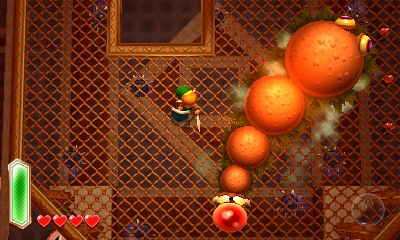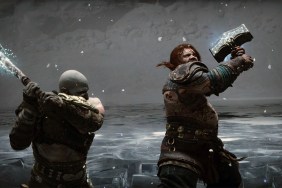A Link to the Future.
I sit somewhere outside the mainstream Zelda fan. I only played Ocarina of Time for the first time on 3DS recently, but I’ve played A Link to the Past (LTTP) on both Super Nintendo and Game Boy Advance. I’ve always been satisfied with the predecessor to the "Greatest Game of All Time," as the structure of adventuring from temple to temple got perfected in 1991, not 1998. Discovering the tools Link needs and meeting the Gorons and Zoras have been staples of the series, but LTTP was just low-fi enough to leave a lasting storybook sense of wonder.
Ocarina of Time instills fear—it’s dark and ominous—but the 2D adventure on SNES defined a 3D future, and I still think LTTP is the better game today. When I picked up the latest Legend of Zelda game subtitled A Link Between Worlds, I didn’t expect to love its new system for handing out items or how heavily it plays on its Super Nintendo predecessor, but I do. In subverting now tried-and-true Zelda formulas, A Link Between Worlds celebrates players as a hero lost in time and innovates on franchise hallmarks that have grown stale.
The first and most obvious change to Zelda-by-the-numbers comes in the form of Rovio, a purple-hooded shopkeep who lends Link the tools he needs to progress through the game’s dungeons, for a fee of course. Between both light and dark worlds, dungeons dot the map in droves, but each teases the player deeper and deeper inside until he or she has learned all kinds of tricks with rented toys. Link can solve puzzles to find heart pieces, valuable rupees, and fight off monsters for keys. Not only can Link obtain more items earlier than he could in past Zelda games, he also moves and attacks faster.
Fans of LTTP will recognize the mechanical speed, but overall A Link Between Worlds atones for what fans might have felt were sins in Skyward Sword. Twilight Princess toed the line, but much of the Wii’s second Zelda game padded the moment-to-moment developments and left more experienced adventurers wanting for excitement. Here, it’s only minutes between the start of the game, Link’s first sword, his first adventure across the Hyrule countryside, and his first dungeon. Sooner still do players obtain the bow and arrow and meet Rovio and another helpful character.
As players explore the game world, they’ll discover weather vanes outside both light and dark landmarks to which the helpful witch Irene, who calls Link “Greenie," shuttles players, making it easier than ever to leap around the map. Objectives near and far always stay within reach and it’s an appropriate replacement for Epona in the 2D setting, even if I can hardly call A Link Between Worlds a 2D game.

In fact, players will find perhaps the 3DS handheld’s best 3D effect yet and an interesting twist on Zelda puzzle design through Nintendo’s use of deep top-down visuals. When a certain someone with a magic paintbrush tries to resurrect the demon king Ganon, Princess Zelda entrusts Link with the Stone of Courage and Rovio gives Link a special bracelet that lets him escape from the paint prison holding sages against their will. Link can navigate the walls by magically painting himself wherever possible and popping back off the wall where valuable items or important objectives await. The camera swoops down from its overhead perspective and players can watch 2D Link shuffle side-to-side.
While I originally thought this mechanic served as a gimmick every new Zelda game has to have (like Link turning into a wolf), it’s a meaningful turn on classic 2D map design. Link to the Past frequently teased players through every dungeon with a map and compass, but the map gets displayed on the bottom screen as soon as Link enters a temple in this new adventure. He can still find the compass to reveal every secret treasure chest, but with the wall ability and the touchscreen’s map, discovering hidden treasure chests is only a matter of curiosity. Still, be sure to rent all the items Rovio makes available as doing so makes A Link Between Worlds more entertaining for experienced gamers and a good learning experience for newcomers.
For better or worse, new heroes will miss out on the frustration normally felt by finding a hidden goodie without the right tool. Getting access to Rovio’s supply of goods will cost rupees, though I’ve never played a Zelda game before by walking past all the pots and patches of grass that contain hearts and currency. By making key items rentable, a player’s incessant hoarding of gems has purpose. If Link dies, he’ll have to buy up all the valuable tools again. With a wallet unlimited in capacity it’s easy to shrug off a bad boss fight, but make too many stupid mistakes and the price may be too great to pay.

Experienced Zelda fans will want to hold onto every green, blue, red, purple, and silver rupee they find and by the end of the game it’ll be easy to boast to friends about no-death riches. I suffered my first death relatively early in the game. That’s not to say there isn’t a wealth of content or that combat and item drops aren’t balanced, but I was screwing around and I fell into several endless pits. When my health finally dropped to zero, I decided to buy one tool and try to make my way through the dungeon with less gear-switching.
Solving puzzles only to return later for hidden treasure still satisfies as it did in past Zelda games, especially because players will get to revisit some delightful characters with witty, fourth-wall-breaking dialog. Still, I like the risk-reward balance that comes from outfitting Link with all of Rovio’s wares before setting off for adventure. In short, a winking reliance on nostalgia and Link’s ability to merge with the walls around him make this one of the best Zelda games in recent memory.
Plunging into dungeons or running about an overworld setting from a top-down 2D perspective requires completely different thinking compared to navigating the walls that stand tall with the 3D slider at max. Even better, not every puzzle can be solved by Link’s toys or his newfound power. A Link Between Worlds works hard to push players into a new adventure and succeeds by teaching old dogs new tricks. For younger gamers it’ll still be fun to run around the countryside and fight little, green bogeymen, but they’ll probably need help to progress further in the game’s narrative.

Despite my growing experience with Zelda games, I still got lost from time to time. I feel like the 'X' on the map isn't enough direction and I wish more NPC characters could highlight the way if it’s clear I don’t know what I’m doing. Link is the adventurer that legend spoke of, but without patience it’ll be easy to get lost and frustrated. Every character offers meaningful advice so reading and investigating visuals clues becomes more important as the story progresses.
Regardless, A Link Between Worlds engages the player, quickly leveraging plenty of Zelda lore and a gripping narrative, with not an ounce of fat on it. After starting the game, I played for 6 hours straight before going to sleep way past my bedtime. Players might fall in love with the numerous puzzles and overflowing charm, they might enjoy skipping back and forth between light and dark worlds, or they might enjoy the references to past games. Whatever the case, the hours fly by thanks to Nintendo’s dogged determination to keep Link and Hyrule relevant.
A Link Between Worlds gets fearless and distinguishes itself from the franchise’s history. On top of that, Link, Zelda, Rovio, and some of the best bosses Zelda fans will ever fight turn that history on its head, both narratively and mechanically. This is another must-play 3DS game and a compelling adventure for anyone traveling this holiday season or curling up with a good game at home.
Code provided by publisher. 3DS exclusive.
-
Gorgeous graphics top-down and on the wall
-
Fast, intense combat and tight controls
-
Gripping narrative that doesn't waste time
-
Playing on nostalgia and the franchise's long history
-
A hero of time is you
-
Ingenius dungeon and puzzle design
-
Risk-reward system in renting items
-
Makes every life precious or else your wallet suffers
-
Getting lost on occasion
-
Great 3D effect but really drains battery
-
Great soundtrack but some tracks get repeated










